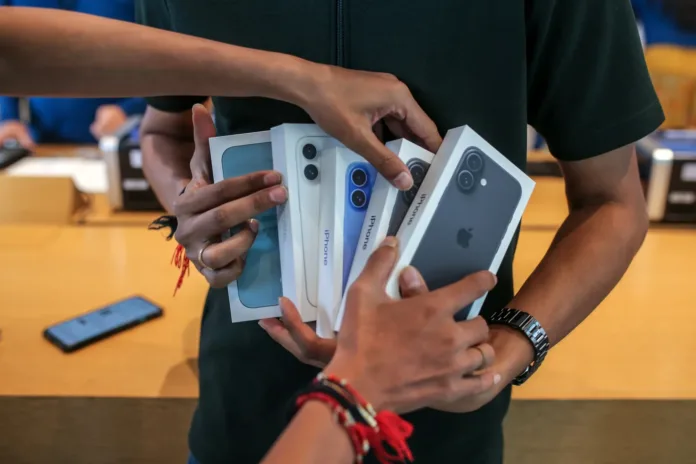The Article Tells The Story of:
- Apple Targets Full iPhone Shift to India by 2026 — Over 60 million iPhones for the U.S. could soon be made in India.
- Trump’s Trade War Sparks Major Supply Chain Shift — High tariffs force Apple to leave China for India.
- Apple Races to Expand Indian Manufacturing — Foxconn and Tata ramp up production to meet U.S. demand.
Apple Responds to Tariffs by Leaving China for India
Apple is preparing to move all U.S.-bound iPhone production to India by 2026. This change comes as a direct response to trade policies introduced by former U.S. President Donald Trump. People familiar with the matter say Apple plans to begin this shift as early as next year.
Read More About Our Article of Shein, Temu, and Brands Scramble for Solutions: Trump’s Tariff Order Shakes E-Commerce Published on February 7, 2025 SquaredTech
For years, Apple relied heavily on China for manufacturing. However, Trump’s trade war imposed steep tariffs on Chinese imports, affecting Apple’s profit margins. In response, Apple began expanding operations in India. The company now wants to assemble over 60 million iPhones a year for the U.S. market directly from India.
This goal would require Apple to double its current production output in India. Achieving this would mark a major shift from Apple’s previous investment strategy, which focused on building a large-scale production network in China over two decades. Apple’s long-term growth has been tied to this Chinese manufacturing system. But now, economic pressure is forcing change.
Apple works with major partners like Foxconn and Tata Electronics to assemble iPhones. While India has started making iPhones, the final assembly step still heavily depends on Chinese components. That final step—where parts come together into a finished phone—is what Apple wants to shift to India.
Trump’s Trade War Hits Apple’s China Strategy
Trump introduced “reciprocal” tariffs of over 100% on imports from China. Though he paused some of these tariffs for smartphones, a 20% tariff still applies to iPhones made in China. Apple, which manufactures most iPhones through third-party companies like Foxconn, faced direct financial impact.
India also received a 26% reciprocal tariff, but this is currently paused. The Indian government is pushing for a trade agreement with the U.S. During a recent visit to India, U.S. Vice President JD Vance said both nations are making “very good progress” on the deal.
In 2024, about 28% of Apple’s global iPhone shipments—roughly 65 million units—went to the U.S., based on International Data Corporation estimates. Apple will need to expand manufacturing in India significantly to meet this level of demand.
Last year, Apple ramped up Indian production. Foxconn and Tata started importing pre-assembled component kits from China. This helped speed up final assembly inside India. But full independence from China will still take time, as Apple remains reliant on many Chinese suppliers for parts.
According to Daniel Newman, CEO of the Futurum Group research firm, “Apple is moving fast to reduce tariff risks. This shift shows how quickly the company can act when profits are threatened.”
India Gains as Apple Doubles Down
Apple began producing some iPhones in India years ago. But the company still relied on China for the majority of its output. Trump’s aggressive trade strategy has now forced Apple to rethink that approach.
After Trump’s tariff plans wiped out $700 billion from Apple’s market value, the company scrambled to find alternatives. One move was to increase exports of Indian-assembled iPhones to the U.S. This helped Apple avoid the steep tariffs on Chinese imports.
Apple is expected to report quarterly earnings next week. Investors are watching closely to see how the tariff situation affects the company’s financial results. Apple usually does not provide detailed guidance and has not directly commented on the tariffs.
CEO Tim Cook has stayed in close contact with U.S. officials, including President Trump. Cook even attended Trump’s inauguration in January and continues to speak with his administration regularly.
So far, Apple has declined to comment publicly on its plan to move all iPhone assembly for the U.S. market to India.
A Massive Shift Ahead for Apple and the Global Supply Chain
Moving production of all U.S.-bound iPhones from China to India is a bold and expensive move. But Apple appears ready to make that investment. The shift reflects a broader trend of U.S. companies reducing exposure to China and building new supply lines elsewhere.
Apple’s Indian partners, including Tata and Foxconn, will likely see a major expansion in operations. The success of this transition depends on India’s ability to scale up manufacturing and streamline its trade relationship with the U.S.
As tensions between the U.S. and China continue, companies like Apple face increased pressure to adapt. The Indian government has welcomed the chance to boost its tech manufacturing sector, and the U.S. is watching closely.
With over a quarter of its iPhone sales going to the U.S., Apple cannot afford supply chain disruptions. The company’s push to source all U.S. iPhones from India shows how serious it is about protecting its business from political risk.
Whether Apple can fully cut its reliance on Chinese suppliers remains to be seen. But the message is clear: India is becoming Apple’s new production hub for the U.S. market.
Stay Updated: Tech News


